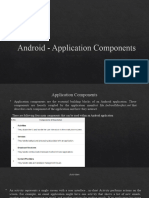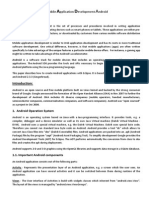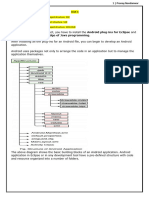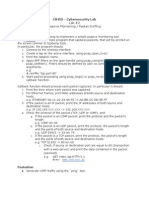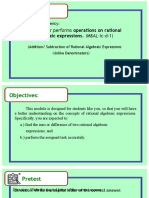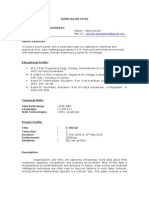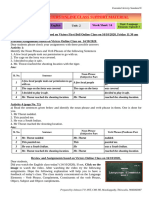Building HelloWorld Android Application Step by Step.
Sang Shin Michle Garoche www.javapassion.com Learn with Passion!
1
�Disclaimer
Portions of this presentation are modifications based on work created and shared by the Android Open Source Project
> http://code.google.com/policies.html
They are used according to terms described in the Creative Commons 2.5 Attribution License
> http://creativecommons.org/licenses/by/2.5/
�Goals of This Presentation
Get you started with Android application development with minimum knowledge Get you know the development environment
> Will focus on Eclipse-based Android development
environment (instead of command-line-based one)
Get you be exposed to the basic building blocks of an Android application in a cursory manner
> The details will be covered in the rest of the course
�Topics
Installation and configuration Building blocks of Android application
> > > > >
Activities Layout resource files AndroidManifest.xml Resource files - strings.xml R.java (created for you)
�Installation & Configuration
�Software Needed
JDK (Java Development Kit)
> Java programming language is used to build Android
application
Eclipse IDE
> Editor, Debugger, profiler, deployment
Android SDK
> Libraries, samples, documentation, handset
emulators, debugger, command line tools
Eclipse ADT (Android Development Tools) plugin
> Give you a powerful, integrated Android
development environment
�Creating Android Project using Eclipse
Automatic creation of building blocks of an Android application
> > > > > >
Starting Activity class Layout resource file AndroidManifest.xml strings.xml R.java Android library
�Lab Exercise(20 min):
Installation & Configuration Exercise 0 of 6110_android_stepbystep.zip
�Building Blocks of Android Application
�Building Blocks of Android Application
Activity classes Layout resource files Resource files
> strings.xml, etc..
AndroidManifest.xml R.java (automatically created from resource files) Android library (automatically configured)
10
�Building Blocks of Android Application
11
�Activity Class - Quick Overview
Each Activity class typically represents a screen
> Like a JSP page in a Web application
The onCreate() method of Activity class gets called by the Android system when your Activity starts
> You create your screen UI inside onCreate() method
Every Activity has to be described in the AndroidManifest.xml file An Activity is typically chosen as a starting one of your application - like a class that has a main() method in Java
> Through special configuration in AndroidManifest.xml
12
�Activity Class Example
package com.javapassion; import android.app.Activity; import android.os.Bundle; public class HelloWorldActivity extends Activity { /** Called when the activity is first created. */ @Override public void onCreate(Bundle savedInstanceState) { super.onCreate(savedInstanceState); // Create UI using Layout resource file setContentView(R.layout.main);
13
�Layout Resource Files
Every screen has a corresponding layout resource file
> Unless you create screen UI programmatically
Each activity class specifies which layout resource file to use for each screen it represents
> Using setContentView(R.layout.main);
Located under /res/layout directory
> /res/layout/main.xml layout resource file is referred
to as R.layout.main
14
�Layout Resource File Example
15
�Resource Files - strings.xml
Let you define the text strings of your applications in a well-known file
> Rather than in Java code > Rather than in Layout resource files
The strings are then referred to through the names assigned to them
> The mapping is done through R.java > @string/hello (in the layout resource file) > R.string.hello (in the Java code)
Located under /res/values directory
16
�strings.xml Resource File
17
�AndroidManifest.xml file
Every application must have a manifest file called AndroidManifest.xml file (with precisely that name) in its root directory. The manifest presents essential information about the application to the Android system, information the system must have before it can run any of the application's code.
18
�Info. in AndroidManifest.xml file
Java package for the application.
> The package name serves as a unique identifier for the
application.
Application name and icon Application version information Activities
> One activity is designated as a starting Activity
19
�AndroidManifest.xml
<?xml version="1.0" encoding="utf-8"?> <manifest xmlns:android="http://schemas.android.com/apk/res/android" package="com.example.helloandroid" android:versionCode="1" android:versionName="1.0"> <application android:icon="@drawable/icon" android:label="@string/app_name"> <activity android:name=".HelloAndroid" android:label="@string/app_name2"> <intent-filter> <action android:name="android.intent.action.MAIN" /> <category android:name="android.intent.category.LAUNCHER" /> </intent-filter> </activity> </application> <uses-sdk android:minSdkVersion="7" /> </manifest>
20
�AndroidManifest.xml
21
�R.java
Automatically created by Android system for all resources defined
22
�R.java
23
�Lab Exercises(60 min):
Exercise 1-7 of 6110_android_stepbystep.zip
24
�Thank you!
Check JavaPassion.com Codecamps! http://www.javapassion.com/codecamps Learn with Passion!
25 23






















